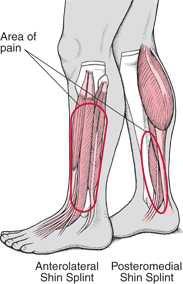Shin and lower leg pain, commonly referred to as shin splints, is common among athletes. Although it doesn’t occur too often among cyclists, it can happen if you increase your cadence or hit the hills without proper training. Cycling shin pain can range nothing more than a nuisance to a major, debilitating issue. There are many ways to both prevent and treat shin splints, and with proper treatment, you’ll be back on your bike in no time.
Athletes with shin splints are often recommended to bike while they heal from shin pain. This is because biking is generally less taxing on the legs than running, walking, and other athletic endeavors. But try telling that to a cyclist who is experiencing shin pain! The truth is, shin and lower leg pain can strike anyone, and once it occurs it often gets worse before it gets better. Fortunately, there are a number of home treatments that will help alleviate your pain and tenderness. There are also techniques you can use to prevent shin splints in the future.
For a free legal consultation,
call 1-844-242-9253
Shin splints can develop over time when you overwork the muscles, bones, and tendons in the lower leg. This can be caused by overuse or not taking proper rest between rides. It can also occur if you ride too much in high gears or have your saddle set at an improper position. Stress fractures can occur from ongoing wear and can cause chronic pain. Sometimes the cause of shin pain is anterior compartment syndrome, which occurs when the muscle of the lower leg swells within its sheath.
When shin pain occurs, there are numerous home treatments to help alleviate the pain. Try applying an ice pack for twenty minutes at a time. This will help deaden the pain and help reduce swelling. Next, massage the shins and lower leg area. This will help stimulate blood flow and reduce the pain. Ibuprofen will help reduce pain while fighting inflammation. If the pain seems excessive or continues despite home treatment, see a doctor. Serious injuries such as fractures can have occurred, even if there was no apparent accident.
Click to contact our personal injury lawyers today
If you have shin splints, it’s appropriate to take some time off and rest your legs. When resting, elevate your legs to allow the swelling to decrease. This is a great time to invest in a new pair of athletic shoes. Buy shoes that offer proper support to your foot. Although multipurpose fitness shoes are usually less expensive, it’s best to buy shoes that are customized to cycling (if you are a cyclist).
Complete a Free Case Evaluation form now
To prevent shin pain from cycling, stretch out your shins and lower legs prior to riding. This warms up the muscles of the shins and prepares them for the stress they face when you ride. Be sure to wear shoes with good support and cushioning. If you experience ongoing shin pain, visit a specialized shoe store or consider consulting with a doctor about orthotics.
The orthotics will provide extra cushioning and support to your foot in the areas of excess stress. Specialized physicians that prescribe orthotics can scan your feet and determine which orthotics are best for your feet.
Another method of prevention is to work on building the muscles in the lower leg. You can begin with lower leg stretches each morning and evening, and slowly build up to more intense exercise that you incorporate into your workouts. By increasing the strength in your lower legs, you will be more able to manage the intensity of your training.
Stop training at the onset of pain. If you feel twinges of pain in your shins (or anywhere else in your body), this is a strong signal it is time to rest. Take control of your body and give it time to recover. It’s never good to push to the point of overexertion. Instead, reduce your training efforts a bit and then increase them again at a slower pace. This will allow your body additional time to recover between workouts.
Generally, shin pain is not a sign of a major injury or condition. Many people experience recurring shin pain throughout their life, especially if they do not allow their shins and lower legs to recover full after stress. If the pain persists longer than a week or so, does not improve with home treatment, or if your lower legs are red or swollen, see a doctor right away for additional treatment. Although uncommon, some causes of shin pain are serious.
Anything that interferes with your cycling regime is bad news, so follow appropriate home treatment recommendations and the advice of your physician and/or trainer. As cyclists and bicycle crash attorneys, we believe it is important to stay on your bike and remain active. That’s why we work so hard to get those injured in bicycle crashes back on their bikes again! We do everything in our power to help those in bicycle crashes recover both physically and financially. Contact the team at Kass & Moses if you are injured in a bicycle crash.
Call or text 1-844-242-9253 or complete a Free Case Evaluation form


